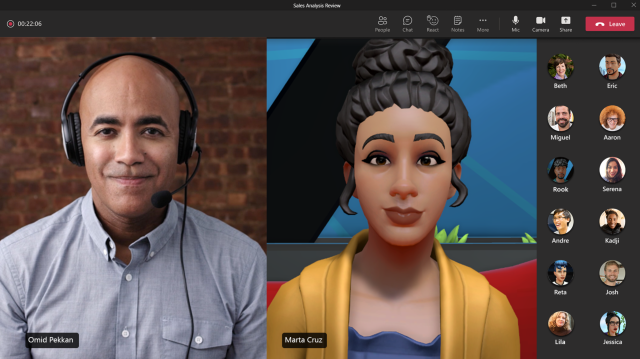The concept rides the recent “metaverse” hype, but it’s only a precursor.
Microsoft has announced its intention to create an immersive 3D platform called “Mesh for Teams” for virtual meetings. As the name suggests, Mesh for Teams builds on the company’s existing Teams collaboration platform and implements the mixed reality features of Microsoft Mesh.
Announced earlier this year, Mesh is a platform for virtual meetings and other collaborative gatherings in mixed reality (a catch-all term for virtual reality, augmented reality, or any combination of the two) using a variety of devices like the company’s own HoloLens products and Windows Mixed Reality headsets, among others. Users would have persistent avatars that accurately reflect their body language and facial expressions and would be able to wander around a virtual workplace.
Workplaces would use Mesh for Teams to invite employees to log in to 3D or 2D collaborative workspaces. Sitting around a virtual conference table, workers would be able to do some things that aren’t possible in the real world. For example, a presenter could see her notes in 3D space near a virtual white board while those watching the presentation only see what she writes on the board.
The service will ship with some pre-built workspaces, but companies will be able to build and customize their own, just like employees can create avatars. None of this will initially require a VR headset; workers would be able to join with smartphones and laptop computers and see the spaces on their screens.
According to Microsoft’s blog post on the subject, the platform will initially just animate avatars’ faces based on audio cues when users speak. But before long, Microsoft plans to bring some basic mirroring of users’ facial expressions to those avatars through the use of webcams.
We’ve seen tech like that in Apple’s Animoji feature for iPhones, the Kinect peripheral for the Xbox 360 and Xbox One, and even in massively multiplayer online games from years ago, like EverQuest II. The technology has also featured prominently on Amazon’s Twitch streaming platform, as in the VTuber movement and innovative streamers like CodeMiko.

Microsoft’s announcement is filled with references to the “metaverse,” which has recently become re-popularized by statements of intent from Facebook-turned-Meta CEO Mark Zuckerberg. The term comes from a science fiction novel titled Snow Crash, though the novel described the feature in dystopian terms, in contrast to the upbeat tone that Meta, Microsoft, and other tech companies leading this wave have struck.
Though Zuckerberg may have recently announced the pivot to the so-called metaverse to distract from Meta/Facebook’s deep and serious problems with its core business, the concept he has picked to champion (and that Microsoft is pushing here as well) predates that move. Venture capital has been pouring into mixed reality workplace startups in unprecedented amounts for a couple of years now.
It’s far from a new idea and was seen in platforms like Second Life (which still exists). But investors and company leaders believe that a combination of the social and cultural effects of the pandemic, coming improvements to VR and AR tech and accessibility, increasingly efficient mobile processors, the expansion of remote work, and new applications of machine learning are paving the way for an immersive, persistent, networked, alternate 3D layer to the workplace that would be natural enough to be appealing to workers and employers alike.
Today, though, there remain major technological barriers to that vision actually coming to pass.
Mesh for Teams is a far cry from what Zuckerberg and others describe for the distant future, which would entail hologram and augmented reality technology rather than or in addition to virtual reality for more natural and comfortable experiences. But it’s Microsoft’s initial attempt to ride the wave of investor and media hype around the so-called “metaverse” concept.
The first version is expected to become available to Teams users sometime in 2022.
Quelle:
Foto: Microsoft / Enlarge / An interface and virtual workspace for Mesh for Teams.
